I was a 19-year-old trainee teacher at college when my ELT methodology tutor wrote the phrase in big letters on the blackboard (yes, it was indeed a blackboard back then – 20th century days):
STUDENT-CENTRED.
I remember reacting, to myself, without saying it out loud:
“How else could our teaching be? We teach a lesson not for us, but for them. Teaching is not about getting OUR job right – it’s about helping students get THEIR job right!”
Later on, as a teacher educator, I understood why this is not so obvious. Or rather, even if it is conceptually obvious, why it is not so easy to implement. I remember the rookie teacher I once was, being more worried about my plan, about my book, about my looks even. It took (quite!) some time for me to be able to move the focus away from all the nerves and thrill of what I was doing and experiencing, and shift it onto what they were doing and experiencing.
Student-centredness revisited
It's only recently, to be quite honest, that it dawned on me how technology (if you can’t beat it, join it!) can help us reimagine student-centred approaches to learning. Being student-centred, even when you’re convinced that it’s the way to go, can prove to be demanding: large classes, heterogeneous groups, limited time…
AI and other technologies have helped to create adaptive learning systems: pupils can learn in personalised ways, and teachers can get meaningful insights of individual and whole-group realities - without having to create customised material from scratch. Plus, in terms of institutional accountability, leadership and administration teams can have a good overview of how things are going. They get access to the big picture of each class, of comparative classes, and therefore of the whole school.
Discover the smart way to boost engagement, learn more about Express DigiPlus!
The fun of sampling a platform
I tried out Express Publishing’s Express DigiPlus platform as I wrote this, and put myself in the position of a B2 student. I started my experience with a reading comprehension sequence. I liked the fact that it was enough to highlight the relevant bit of text in order to provide an answer (Fig 1). There is actually an interesting scaffolded effect: students are first exposed to the text through short passages and a more limited set of questions, before the larger text appears, with a wider variety of exercises.
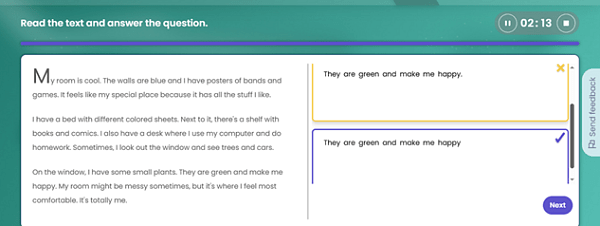
Fig 1. Scaffolded reading. Guess what the question was!
The platform next suggested practising pronunciation. I had fun mouthing what sounded like a tongue twister, with wording based on the student’s profile, guided by CEFR standards (Fig 2). I do admit to feeling relieved that I got 100% in my pronunciation assessment 😊.

Fig 2. Practising pronunciation
I loved what happened next. “Repetition matters”. Yes! (Fig 3).
Since when did repetition become a bad word? I always ask teacher trainees if they know how to drive – if they do, can they reflect on how much repetition they needed until they’d fully acquired each sub-skill involved in the complex process of driving a car?
Lightbrown and Spada (2013) say it best: "Frequent and meaningful repetition of vocabulary and grammatical forms can significantly enhance learners’ ability to retrieve and apply these forms in real communication." (my emphasis).
Why Revision Matters: How DigiPlus Reinforces Learning, Tracks Progress, and Builds Student Agency
Another thing: let’s look back at what we’ve already learned. Observing hundreds of teachers throughout the years, it never ceases to amaze me how we might leave this for the last-class-before-a-test revision – rather than cyclically including revision at every step of the way. Advance, review; learn something new; review; fresh unit; review. The platform reinforces the points that students got wrong and offers them the chance to re-do a task, after giving feedback.
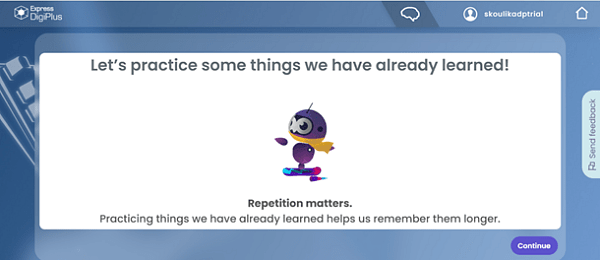
Fig 3. Repetition and revision.
Last bit of my journey: a useful drag-and-drop review of language already learnt (Fig 4.) followed by a reflection of the items that were included in the exercise (Fig. 5)
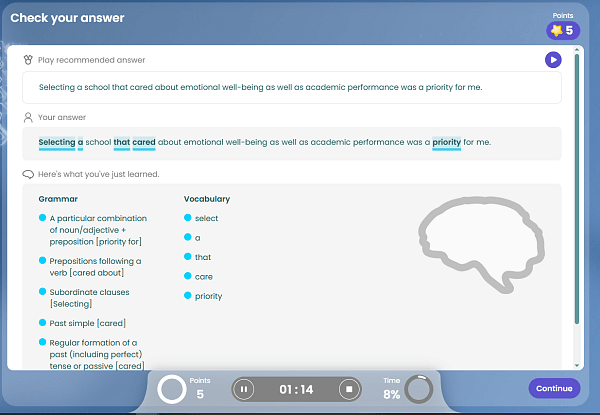
Fig 4. Drag-and-drop for collocations and colligations.
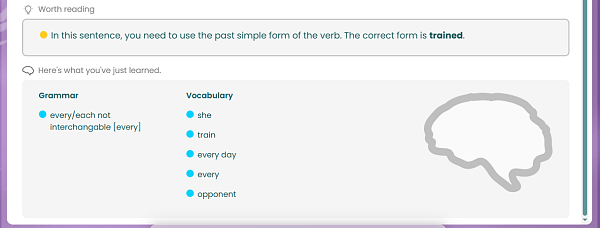
Fig 5. The metalinguistic reflection of the items practised.
Global highlights for me in using DigiPlus are the record it keeps of your overall CEFR level (Fig 6), of your number of exercises completed (even in comparison with the rest of the class, Fig 7), and of dates and times elapsed since you started on your learning journey (Fig 8).
Working like this can clearly contribute to students’ self-regulation, agency and metacognition. Both skills and individual knowledge points (grammar structures & vocabulary) are practised and listed separately on the dashboard, providing a very clear and graphic sense of progress.
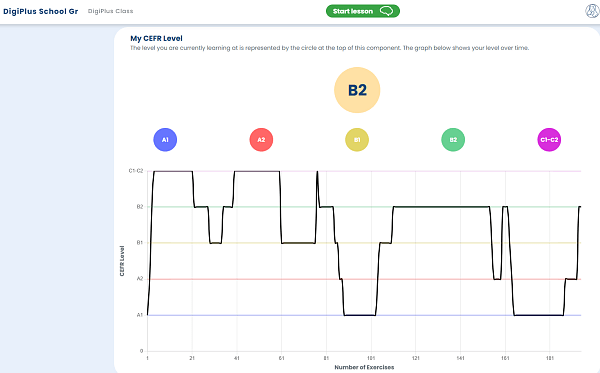
Fig 6. The student’s level based on their progress
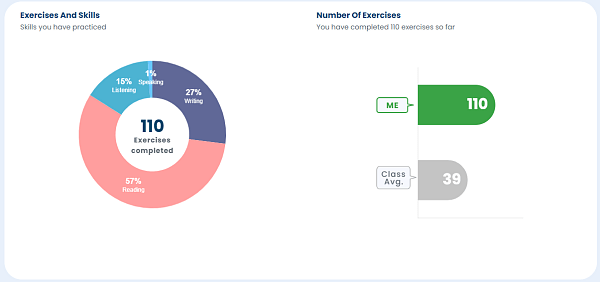
Fig 7. My progress and how it compares to my class.
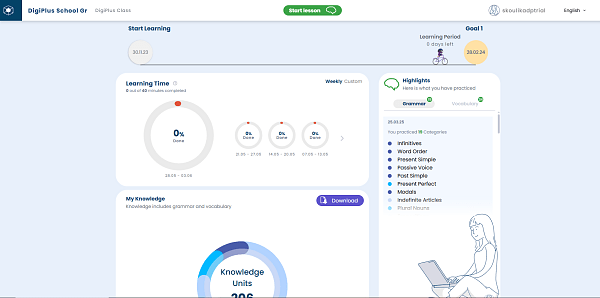
Fig 8. Dates, times, topics, goals: an adaptive language portfolio!
Win-win for all
It would be reductionistic to suggest that students’ or teachers’ lives have been magically resolved by technology or AI.
The language journey remains wonderfully complex. It is actually because of this complexity that the benefits of adaptive learning platforms shine through. Besides the use of digital tools per se, which most of our students enjoy, there’s nothing like feeling that a system (besides their teacher of course!) is following their progress, and taking into account what they are like as a learner, and as a person. This may be particularly important in terms of differentiation, and for students with certain special needs.
For teachers, who often have to struggle with complex realities and demands, effectively planning for learning and assessment is relieved by such digital tools, which enable us to keep tabs both on individual pupils – with information that is also useful data for families – as well as whole groups – with information that is also useful for school management.
Adaptive learning systems are here to stay, and all stakeholders in the language learning process have much to gain from adopting them, and from maximising their potential.
About the author:
Leandro Paladino is a teacher educator and academic leader with over 30 years’ experience in English language teaching. He has taught English grammar and Discourse Analysis at undergraduate and postgraduate levels and has supervised and assessed numerous dissertations. Leandro has delivered workshops and conference presentations nationally and internationally and worked as a speaker and materials writer for major publishers. He is deputy editor of the EAL Journal (UK) and a trustee of NALDIC. He also co-coordinates IATEFL’s Young Learners and Teenagers SIG, helping lead its events, journal, and blog. He designs and oversees teacher development and multilingual education programs.
Looking for more information about DigiPlus and its benefits?
DigiPlus: Our Adaptive Learning Tool: Discover how Express DigiPlus uses AI to personalise learning, boost engagement, and support teachers every step of the way.
Why DigiPlus Works: Real Stories of Impact: Explore real classroom stories that show how adaptive learning with DigiPlus transforms teaching and drives student success.
AI-Powered Learning: A Game-Changer Outside the Classroom: See how DigiPlus extends personalised learning beyond school walls, fueling independent study, progress tracking, and student agency.
-1.png)






